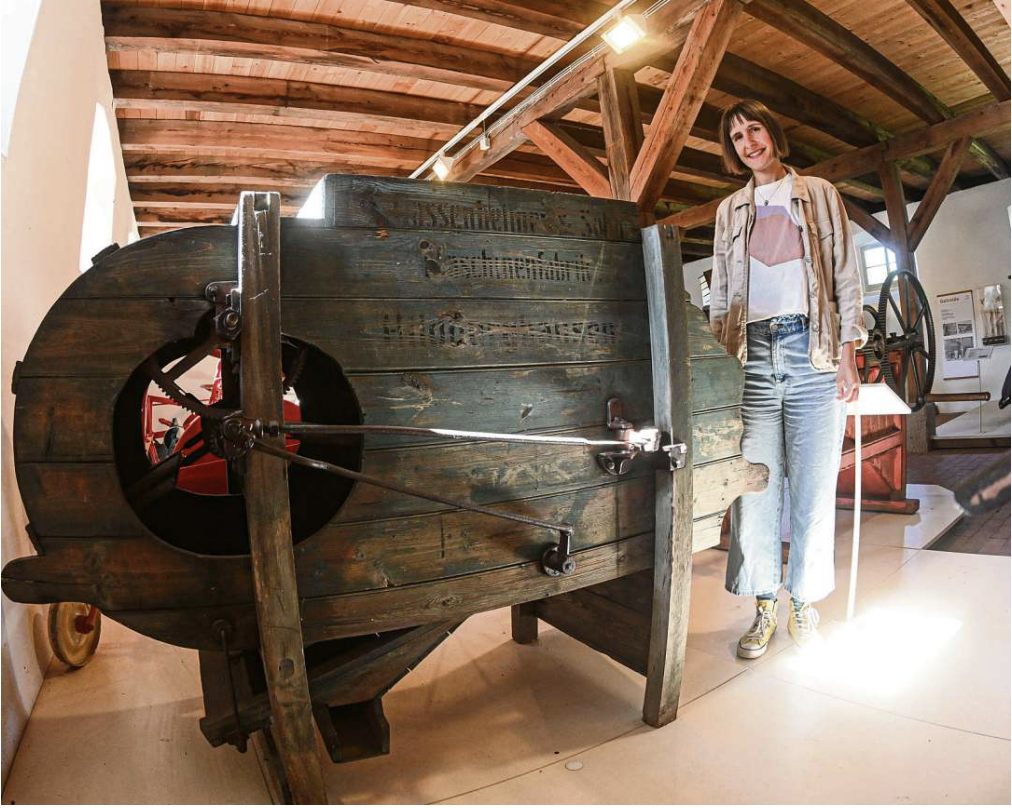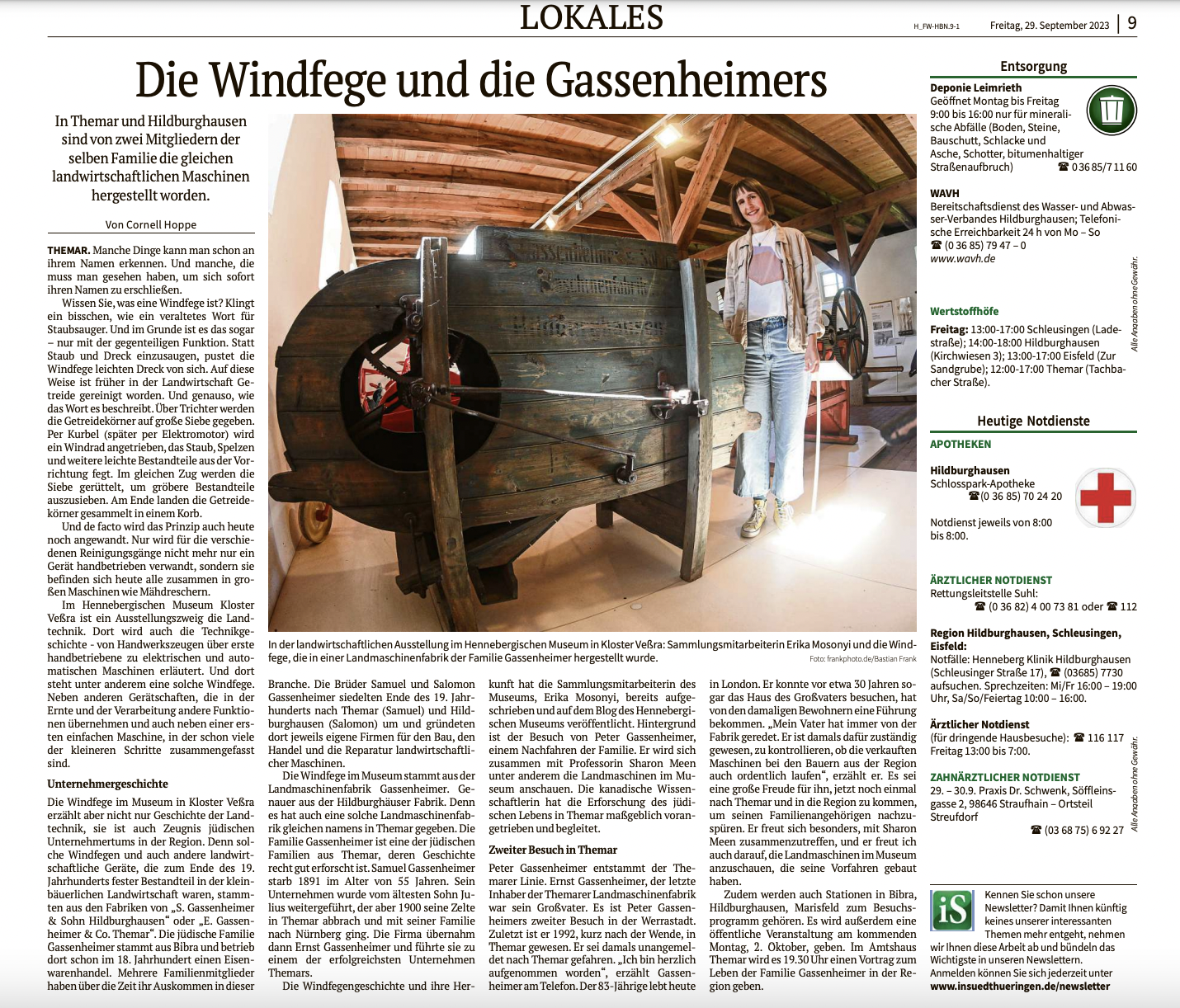In Themar and Hildburghausen, two members of the same family made the same agricultural machinery.
By Cornell Hoppe
THEMAR. Some things can be recognized by their name. And some things you have to see to immediately understand their name. Do you know what a wind sweep is? It sounds a bit like an outdated word for a vacuum cleaner, and in fact it is – but with the opposite function. Instead of sucking in dust and dirt, the wind sweep blows light dirt away from itself. This is how grain used to be cleaned in agriculture. The grains are fed through funnels onto large sieves. A crank (later an electric motor) drives a windmill that sweeps dust, husks and other light particles out of the device. At the same time, the sieves are shaken to sift out coarser particles. At the end, the grains are collected in a basket. In fact, the principle is still used today. The only difference is that the various cleaning operations are no longer carried out by a single hand-operated machine, but are now all carried out in large machines such as combine harvesters. In the Henneberg Museum in Kloster Veßra, one branch of the exhibition is agricultural technology. The history of technology – from hand tools to the first hand-operated to electric and automatic machines – is also explained there. And there, among other things, is such a wind sweep. Next to other tools, which take over other functions in harvesting and processing and also next to a first simple machine, in which already many of the smaller steps are summarized.
The wind sweep in the museum in Kloster Veßra not only tells the story of agricultural technology, it also bears witness to Jewish entrepreneurship in the region. This is because such wind sweeps and other agricultural implements, which were an integral part of small-scale farming at the end of the 19th century, came from the factories of “S. Gassenheimer & Sohn Hildburghausen” or “E. Gassenheimer & Co. Themar”. The Jewish family Gassenheimer originated from Bibra and operated a hardware store there already in the 18th century. Several family members made their living in this business over time. The brothers Samuel and Salomon Gassenheimer moved to Themar (Samuel) and Hildburghausen (Salomon) at the end of the 19th century and founded their own companies for the construction, trade and repair of agricultural machinery. The wind sweep in the museum originates from the agricultural machinery factory Gassenheimer. More precisely from the Hildburghausen factory. The Gassenheimer family is one of the Jewish families from Themar whose history is well researched. Samuel Gassenheimer died in 1891 at the age of 55. His business was continued by his eldest son Julius, but in 1900 he broke off his tents in Themar and went with his family to Nuremberg. Ernst Gassenheimer then took over the company and led it to become one of Themar’s most successful enterprises. The wind sweep story and its origin has already been written up by the museum’s collection assistant, Erika Mosonyi, and published on theBlog of the Henneberg Museum. The background is the visit of Peter Gassenheimer, a descendant of the family. He will look at the agricultural machinery in the museum together with Professor Sharon Meen, among others. The Canadian scientist has significantly advanced and accompanied the research of Jewish life in Themar.
Second visit to Themar Peter Gassenheimer is descended from the Themar line. Ernst Gassenheimer, the last owner of the Themar agricultural machinery factory was his grandfather. This is Peter Gassenheimer’s second visit to the Werra town. The last time he was in Themar was in 1992, shortly after the fall of the Berlin Wall. At that time, he said, he drove to Themar unannounced. “I received a warm welcome,” Gassenheimer says on the phone. 83-year-old Gassenheimer now lives in London. About 30 years ago, he was even able to visit his grandfather’s house and was given a guided tour by the former residents. “My father always talked about the factory. At that time, he was responsible for checking that the machines sold to farmers in the region were running properly,” he says. He says it is a great pleasure for him now to come back to Themar and the region to trace his family members. He is especially looking forward to meeting Sharon Meen, and he is also looking forward to seeing the farm machinery in the museum that his ancestors built. Stops in Bibra, Hildburghausen, Marisfeld will also be part of the visit program. There will also be a public event next Monday, October 2. In the Amtshaus Themar there will be 19.30Uhr a lecture on the life of the family Gassenheimer in the region.
Translated with www.DeepL.com/Translator (free version)

